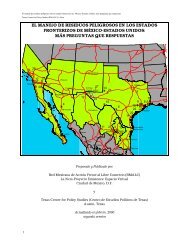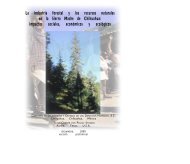Pesticides and Water Quality - Texas Center for Policy Studies
Pesticides and Water Quality - Texas Center for Policy Studies
Pesticides and Water Quality - Texas Center for Policy Studies
You also want an ePaper? Increase the reach of your titles
YUMPU automatically turns print PDFs into web optimized ePapers that Google loves.
III. PESTICIDES IN TEXAS GROUND WATERA. IntroductionWhen first introduced into widespread use, pesticides were not deemed to be a threat to ground water.Early pesticides, such as arsenic, <strong>and</strong> the post-World War II synthetic pesticides, such as DBCP 116 , werethought either to be captured in soils or to degrade quickly. That theory was shattered in the 1960s <strong>and</strong>1970s, with proof that many pesticides were very persistent in the environment, <strong>and</strong> that some pesticideswere showing up in aquifers which provided drinking water to rural <strong>and</strong> urban residents.As in most states with significant agricultural production, <strong>Texas</strong> has found pesticides in a number of itsaquifers. Unlike some states, such as Ohio <strong>and</strong> Wisconsin, <strong>Texas</strong> has not pursued a comprehensiveprocess <strong>for</strong> detecting or reporting pesticides in ground water or <strong>for</strong> evaluating the significance of theproblem. Even with the creation of an inter-agency ground water protection committee by the <strong>Texas</strong>Legislature in 1989, collection of data <strong>and</strong> the evaluation of risks have been slow.As this inter-agency committee has pointed out, however, “data gaps” (such as the lack of pesticide use<strong>and</strong> fate data) are barriers to an effective program. 117 As discussed in a previous TCPS report, 118 <strong>Texas</strong>does not have a program <strong>for</strong> systematic reporting or collecting of pesticide use data, even in areas of thestate with very vulnerable groundwater systems, such as the recharge zone <strong>for</strong> the Edwards Aquifer.In addition, rural l<strong>and</strong>owners have been reluctant to allow voluntary sampling of their water wells byrepresentatives of state regulatory agencies. Thus, <strong>Texas</strong> agencies have not been able to evaluate theextent of the contamination problem, even <strong>for</strong> high-profile pesticides like atrazine. 119 For example, the<strong>Texas</strong> Groundwater Protection Committee (TGPC) identified an area along the Brazos River Alluvium insoutheast <strong>Texas</strong> 120 as a region where atrazine is likely used <strong>and</strong> ground water is vulnerable tocontamination. The TGPC designed a study program <strong>for</strong> the area, but could not carry it out. Farmers inthe area would not allow their wells to be sampled <strong>for</strong> atrazine by representatives of the state agencies.While the members of the TGPC have the authority to go on the l<strong>and</strong>s to sample the wells, they arereluctant to do so if farmers or ranchers object. Thus, TGPC only took samples from a few public wells,leaving the study with little scientific value.The Brazos River l<strong>and</strong>owners, like others in <strong>Texas</strong>, are concerned that if they allow government agenciesto sample their water wells <strong>and</strong> the tests indicate contamination, these agencies will seek penalties fromthe l<strong>and</strong>owners, even if the l<strong>and</strong>owners have always used the pesticides in accordance with the label.116 Dibromochloropropane was banned in the late 1970s. It had been widely used to kill nematodes in soils. It is suspected tocause sterility in men, as well as cancer. It is also suspected of being a testicular toxin. It has been found in wells in a numberof states <strong>and</strong> <strong>for</strong>eign countries. The Leaching Fields: A Non-Point Threat to Groundwater, prepared by the Assembly Office ofResearch <strong>for</strong> the Cali<strong>for</strong>nia Legislature, March 1985, pp. 84-87.117 See, <strong>for</strong> example, the draft report of the Data Evaluation Task Force of the <strong>Texas</strong> Groundwater Protection Committee of May6, 1997. The Task Force found “that the current data are insufficient to conclude that all ground water susceptible areas of thestate are unaffected by non-point source contamination by atrazine.... The present data base contains in<strong>for</strong>mation of variablequality collected <strong>for</strong> various purposes.”118 <strong>Texas</strong> <strong>Center</strong> <strong>for</strong> <strong>Policy</strong> <strong>Studies</strong>, Realm of the Unknown: Pesticide Use in <strong>Texas</strong> (<strong>Texas</strong> <strong>Center</strong> <strong>for</strong> <strong>Policy</strong> <strong>Studies</strong>: Austin1999).119 Id.120 These alluvial or bolson deposits range from one to seven miles wide along 350 miles of the River. They provide asignificant amount of water <strong>for</strong> irrigation. See, <strong>Texas</strong> Department of <strong>Water</strong> Resources, Ground <strong>Water</strong> Availability In <strong>Texas</strong>,Report No. 238, (TWDB: Austin, September 1979).35




